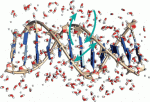
The reorientation and hydrogen-bond dynamics of water molecules within the hydration shell of a B-DNA dodecamer, which are of interest for many of its biochemical functions, are investigated via molecular dynamics simulations and an analytic jump model, which provide valuable new molecular level insights into these dynamics. Different sources of heterogeneity in the hydration shell dynamics are determined. First, a pronounced spatial heterogeneity is found at the DNA interface and explained via the jump model by the diversity in local DNA interfacial topographies and DNA− water H-bond interactions. While most of the hydration shell is moderately retarded with respect to the bulk, some water molecules confined in the narrow minor groove exhibit very slow dynamics. An additional source of heterogeneity is found to be caused by the DNA conformational fluctuations, which modulate the water dynamics. The groove widening aids the approach of, and the jump to, a new water H-bond partner. This temporal heterogeneity is especially strong in the minor groove, where groove width fluctuations occur on the same time scale as the water H-bond rearrangements, leading to a strong dynamical disorder. The usual simplifying assumption that hydration shell dynamics is much faster than DNA dynamics is thus not valid; our results show that biomolecular conformational fluctuations are essential to facilitate the water motions and accelerate the hydration dynamics in confined groove sites.

N’hésitez pas également à consulter le communiqué de presse relatif à cet article : L’eau au coeur de l’ADN
References:
Dynamical Disorder in the DNA Hydration Shell
Elise Duboué-Dijon, Aoife C. Fogarty, James T. Hynes, and Damien Laage
J. Am. Chem. Soc., 2016
doi: 10.1021/jacs.6b02715
Dynamical Disorder in the DNA Hydration Shell
